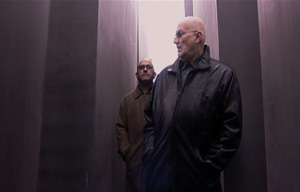Arts
Film
Brief Reviews: How Jews See Themselves—and How Others See Them:

Two Israeli documentaries about anti-Semitism are hitting film festivals and theaters throughout the world. Yoav Shamir’s Defamation pokes fun at Jewish paranoia, questioning the very existence of anti-Semitism, while Naftaly Gliksberg’s Look Into My Eyes unveils a loathing of Jews so virulent it takes your breath away. Compared to the investigative intelligence of Look Into My Eyes, Defamation comes off as puerile and self-serving; to appreciate the weight of Shamir’s concerns, it’s necessary to look beyond the film’s glib exterior. Nevertheless, both films paint a fascinating picture of Jewish identity from within (How do Jews see themselves?) and from without (How do other people see Jews?).
These questions take on a surprising twist when raised by Israelis, some of whom believe that anti-Semitism is nothing other than a manifestation of political conflict in the Middle East. In interviews, both Gliksberg and Shamir expressed the opinion that diaspora Jews call their opponents anti-Semites when they want to silence criticism of the State of Israel.
Given the potency of the anti-Semitism presented in Look Into My Eyes, this point of view is especially surprising coming from Gliksberg, until one learns that he jettisoned it while preparing to shoot his film. When the Gliksberg told his father—an Orthodox rabbi who immigrated to Israel from Poland after the war—that he didn’t believe in modern-day anti-Semitism, his father convinced him to go to Poland to see a reenactment of the Passion of Christ. Says the filmmaker, “When I saw more than 150,000 people marching behind a cross watching a play where the Jewish leaders play devils, I was shocked. It turned me upside down; I stopped and I thought, ‘O.K., let’s start again with my movie.’”
Gliksberg found himself in a quandary. Never having experienced anti-Semitism in Israel, he now had to film head-on a phenomenon he’d neither experienced nor given any credence to. To solve the problem, on both a personal and cinematic level, he filmed himself asking interviewees, “How do you feel about Jews?” His travels took him from an evangelical church in Chicago to the comedy scene in Paris, to Germany, where he interviewed the head of the Holocaust denial movement. “What I learned,” says Gliksberg, discomfort crossing his features, “is that anti-Semitism is so deep in Western culture that for many people it’s part of their identity.”
Shamir, on the other hand, never found a moment’s anti-Semitism in the three years he traveled the world after military service. This conflicted with the constant barrage of articles about anti-Semitism he encountered in Israeli newspapers, as well as what he saw as excessive emphasis on the Holocaust in Israeli schools. To examine the gap between his education and his personal experience, he decided to focus Defamation on Jewish attitudes about anti-Semitism. He followed ADL founder Abraham Foxman from New York to Germany, and interviewed, among others, peace activist Uri Avnery and Norman Finkelstein, author of The Holocaust Industry, who was banned from Israel for ten years in 2008 on the grounds of “security concerns.” While Shamir never explicitly denies the existence of anti-Semitism, he ultimately concludes that looking to the past is keeping Israel from moving forward. He ends Defamation commenting, in voice-over, “Maybe it’s time to live in the present and look to the future.”
The natural question following such a statement is, of course, What does that future look like? When the question was put to both filmmakers, their answers followed, not surprisingly, from their religious and political outlooks.
Shamir describes himself as an atheist. He’s made a number of films critical of Israeli policy. When asked to articulate the future he refers to in Defamation, he replied, “[Zionism] was a term coined over a hundred years ago. Back then it was very different from what it is today. I don’t think that keeping Israel strictly Jewish is something we should strive for. It’s already here. We should progress like other places and make this a place for all, regardless of their religion.”
Gliksberg is the scion of a long line of rabbis; he himself studied for the rabbinate before deciding to become a filmmaker and founding the Maale Film School for observant Jews, where they teach such courses as Cinema Midrash. His response to the question What does Israel’s future look like? was tinged with a degree of sadness. “It’s not new in Jewish history,” he said, “that some Jews wanted to feel they are cosmopolitan people and there is no difference between people of different nationalities. Today,” he continues, “many Israelis, mostly left-wing Israelis, prefer to talk about Israeli identity instead of Jewish identity. They try to exclude themselves from the Jewish people: ‘We are the Israeli people,’ they say. If Israel survives, two or three hundred years from now there may be a new people—an Israeli people—combined from Arabs and Jews, etc., etc. There will be two nations: the Israeli nation and the Jewish nation. They will be different.”
In the end, both Look Into My Eyes and Defamation rest on fault lines: between Jews and non-Jews, between Israelis and diaspora Jews, between Jews who want to forget the past and Jews who strive to link their history with their future. Maybe the next step is to look at the fault lines themselves to arrive at a more synthesized and universal Jewish identity—both from within and from without.










 Facebook
Facebook Instagram
Instagram Twitter
Twitter
Leave a Reply